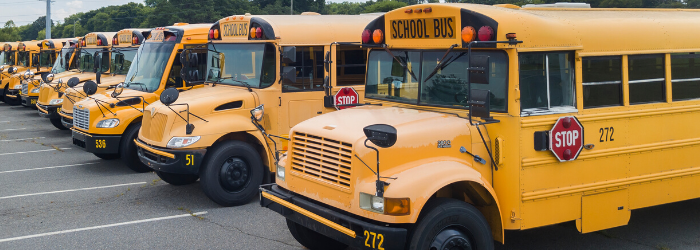K-12 Recovery Local Task Forces
State and Local Task Forces
Many states and districts have created local task forces to plan and manage the reopening of schools.
Here you will find ideas for how to structure an education recovery task force, whom to include and how to communicate its work.Enhance or Establish a Local Task Force
Faced with the daunting task of reopening schools, many states and local districts have assembled task forces to assist with developing plans to support the unique needs of schools responding to COVID-19.
SREB offers the following five potential actions for enhancing or establishing a local task force.
1. Define the problem the task force will address and establish a clear scope and purpose to guide the group’s work.
Task forces can be created to address varied needs. It is essential that leaders clearly define the problem(s) the task force will be asked to address. In many cases, task forces that convened early in the COVID-19 pandemic have now shifted their work to address procedures for closing out the school year and planning for virtual events like graduations. Consider using a calendar of deliverables to support the task force, such as this example:
May
- Solidify end-of-year procedures that comply with social distancing guidelines and local restrictions for facility usage
- Identify tools to support communication with all shareholders
June
- Prepare physical plants for the new school year
- Uniform cleaning practices for buildings
- Procedures for students and staff to enter buildings
- Communicate social distancing and health practices to students, parents and staff
- Expectations for classrooms
- Expectations for common areas
- Expectations for additional school-based events (including limitations)
July
- Create communication and outreach strategies for students, parents and the community
- Address changes in procedures and expectations for school campuses, classrooms and access to support systems
- Establish sanitation practices and expectations
- Promote the importance of learning
- Determine strategies to support student learning while in classrooms
- Identify tools and resources for using technology
2. Define the timeline to support the work that is communicated to task force members and other shareholders.
Share the timeline and scope of work so members can commit to the work, considering questions like these:
- Are current task forces or committees meeting weekly? Is that time commitment limiting participation? Is the existing meeting schedule yielding the desired results?
- Is the group large enough to split into subcommittees or smaller teams on specific priorities?
- Can you adopt a schedule that allows subcommittees to meet every other week and share results with the full task force on alternating weeks?
- How will members attend meetings? Will members be expected to participate in face-to-face sessions or can video conferencing be used?
- Who will be responsible for overseeing and carrying out the different elements of recovery and reopening plans created by the task force?
Members of SREB’s K-12 Recovery Task Force report that task forces in their states started to address remote learning needs in the spring and have evolved to cover solutions for end-of-year events such as graduation ceremonies, summer school and reopening in the fall. They plan to convene at least through June and begin implementing their plans in July.
Some task forces are evolving from planning and guidance to mandating compliance and approving local plans. Many recognize they may need to continue meeting, problem-solving and adapting plans well into the late fall or winter.
Delaware’s task force makes recommendations through the education agency that are then presented to the governor.
The Maryland State Department of Education released its long-term education recovery plan in early May. It aligns with the governor’s state recovery plan and includes options for school systems to consider.
3. Identify and secure task force members, ensuring that membership is balanced and aligns with the group’s communicated purpose.
Many districts already have various ad hoc committees, advisory groups and steering committees. Consider whether you can use pre-established committees or need to create a new task force charged specifically with addressing challenges relating to reopening schools.
SREB compiled the following lists of potential task force members. Use it to brainstorm additional members to invite to your task force or to an existing committee or group.
State or District
Board of education members
Superintendent
Assessment director
Chief academic officer
Communications director
Curriculum and instruction director
Exceptional student services director
Finance director
Federal grants coordinator
Facilities director
Food and nutrition director
Human resources director
Operations director
Policy director
School safety director
Support services director
Technology director
Transportation director
School
Administrators
Teachers
Teachers who support Second Language Learners
Teachers who support Exceptional Needs Students
Counselors
School nurses or other on-site health providers
Parents
Students
Community members
Other Representatives
Associations for teachers, school boards, superintendents and principals
Elected local officials
The state community and technical college system and higher education agency
Childcare agencies or providers
Community support agencies
Public radio and television stations
State or local public health departments
Hospitals or health care providers
Mental health officials or clinicians
Public safety agencies
County emergency management
Telecommunication networks
Workforce development agencies
Business partners
As you consider expanding an existing group or committee or building a new task force, review the list below to safeguard the balance of your team.
Dos and Don’ts of Securing Task Force Members
| Do | Don’t |
|---|---|
| Take a strategic approach to building or revising your task force’s membership. | Ask for volunteers. |
| Ensure membership is diverse and balanced. | Limit the team to those who traditionally participate — “the usual suspects.” |
| Ensure invited members represent the overall demographics of your school and/or district. | Communicate that meetings are optional. This will limit participation and the overall success of your team. |
| Prioritize regional or local experts who understand and can provide guidance on health and safety measures (e.g., health officials, public safety officials). |
Alabama has a separate group tasked with looking at long-term concerns and aligning financial allocations with those concerns.
Virginia has an additional K-12 and higher education task force.
4. Secure background information and available resources.
Gather background information and resources task force members can use to (a) gain an overview of the problem they are trying to address and (b) communicate potential solutions and best practices that already exist. These materials will set the stage for the success of your task force and jump start their work.
Provide opportunities for local experts to share strategies and lessons learned. Invited guests should align with the overall purpose of the task force as well as its calendar of deliverables. Share varied resources from other districts and schools to spark planning. Be careful to share resources that showcase a variety of solutions so the team can brainstorm the ideas that work best for your school or district.
5. Establish a multi-faceted communication plan.
Clear, frequent communications between schools, districts, state agencies, school boards, superintendents’ and teachers’ associations, partner organizations and the public are essential. Most states have websites with information and advice about COVID-19 and updates on education and economic recovery plans. Education departments are sharing information, often daily, through press releases and conferences, social media and the web.
- Post the calendar of task force meetings and resources on school or district websites.
- Use the task force to identify successful communication tools within your community.
- Deploy a communication strategy that provides no-tech, low-tech and high-tech options.
- Keep information flowing up and down the chain of communication between schools and communities and district or state offices. For example, a school seeking a waiver consideration needs to communicate with the district’s central office and the state department of education, then update students, parents and the community.
- Evaluate the communication plan monthly to determine which tools are working and which need to be revisited.
- Provide ongoing updates in alternate formats and multiple languages.
| No-Tech | Low-Tech | High-Tech |
|---|---|---|
| Flyers and “how to” guides that are sent home (in multiple languages) | School-based auto-calls to families | District or school websites |
| Local newspaper promotional segments | Radio broadcast announcements | Related social media resources, like Facebook, Twitter, YouTube and Instagram |
| Television broadcast announcements | Recorded or live-streamed task force meetings |
Mississippi releases daily updates that include guidance and resources for schools and districts.
Alabama is creating a technical manual with sections aligned with the plan for reopening and finishing the school year.
Louisiana has livestreamed Resilient Louisiana Commission meetings and taken questions from the public through email and other means.
Read the notice about SREB’s K-12 Education Recovery Playbook.




